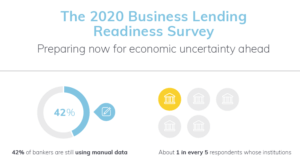Boost efficiency and draw income while managing risk in your construction loan portfolio.
Construction loans can be among the riskier loan types in the portfolio. The tedious and manual processes many financial institutions use only magnify this potential problem in the portfolio without proper management and monitoring.
Download the following infographic to see a comparison of construction loan management using a spreadsheet-based system and a software solution.
Check out other related resources:
- Whitepaper: Red flags and warning signs of contractor failure
- Blog: Managing real estate and construction lending risk
Progress implementing CECL is mixed as the Q1 2023 compliance date nears for smaller SEC-reporting banks and private or not-for-profit institutions.
Here are major findings related to banks, based on Abrigo’s survey of executives, credit and allowance leaders, and other finance staff.
Download the infographic to learn:
- Where banks are in their implementation process
- The top 3 challenges facing banks in their transition
- The impact of CECL on banks’ reserves
In the current environment, core deposit analysis is crucial for helping banks and credit unions remain competitive and profitable. Updated core deposit analytics provide the data for critical assumptions used in asset/liability models (ALM), and impact the overall risk management strategies at a financial institution. In this infographic, learn 6 key reasons to update an institution’s core deposit analysis.
Download to learn:
- How core deposit analysis can aid your financial institution
- Benefits of capturing trends and changes in your customer base
- The importance of core deposit studies in rising rate environments
This resource is part of the series ALM 101: Introduction to Asset/Liability Management.
Small business lending can generate crucial growth for a bank or credit union. For a properly functioning, safe, and growing small business loan portfolio, follow these best practices described by John Barrickman, Principal of New Horizons Financial Group, during a small business lending webinar hosted by Abrigo.
Download to learn:
- Critical elements of a loan policy related to small business lending
- What role the application process plays in a successful program
- The importance of an advisor-like relationship
Check out other small business lending resources:
- Webinar – Win More Deals: Small Business Lending Best Practices
- Whitepaper – Small Business Lending is a Big Opportunity
Adopting the current expected credit loss standard (CECL) will require a well-planned strategy and ample time dedicated to the operational and technical transition. For acquisitive financial institutions, the required efforts might be elevated, as CECL will change how public and private financial institutions account for these acquired assets. This infographic describes the four critical changes related to purchased assets under CECL, as well as a common misconception.
Download to learn:
- The impact CECL has on accounting for impaired loans
- Changes in how acquired assets are defined
- Adjustments to consider for the due diligence phase
- Common misconception related to CECL and business combinations
Asset/liability management is a crucial process designed to maximize an institution’s profitability while managing risk. The broad goal of ALM is to help produce sustainable earnings without compromising other interests of the institution. This infographic breaks down the goal of ALM into three key objectives.
Download to Learn:
- Key profitability outputs ALM measures
- Measured metrics that drive profitability
- Types of risk to consider
- Regulatory expectations
This resource is part of the series ALM 101: Introduction to Asset/Liability Management.
Alignment of critical assumptions and inputs across stress testing, asset/liability management (ALM), and the calculation of expected credit losses is fundamental to a holistic view of risk management. In addition, institutions that identify and manage risk most effectively will outperform their peers in terms of financial performance while also maintaining safety and soundness. In this infographic, learn four ways financial institutions should ensure their allowance for credit losses models under CECL are aligned with the risk management processes of stress testing and ALM.
Time is quickly ticking down for financial institutions adopting the current expected credit loss, or CECL, accounting standard in 2023. As these banks and credit unions work to identify and gather relevant loan-level data and select a methodology for calculating the allowance for credit losses, or ACL, they must also deal with coronavirus-related operational challenges, such as increased loan modifications and credit losses, a surge in fraud attempts, and myriad staffing issues related to the pandemic. Understanding some of the myths and misconceptions about implementing CECL will help these financial institutions avoid some of the hazards to navigating the change.

Download to learn:
- Pain-points discovered within the lending and credit process at financial institutions
- Portfolio strategies of institutions in the coming year


